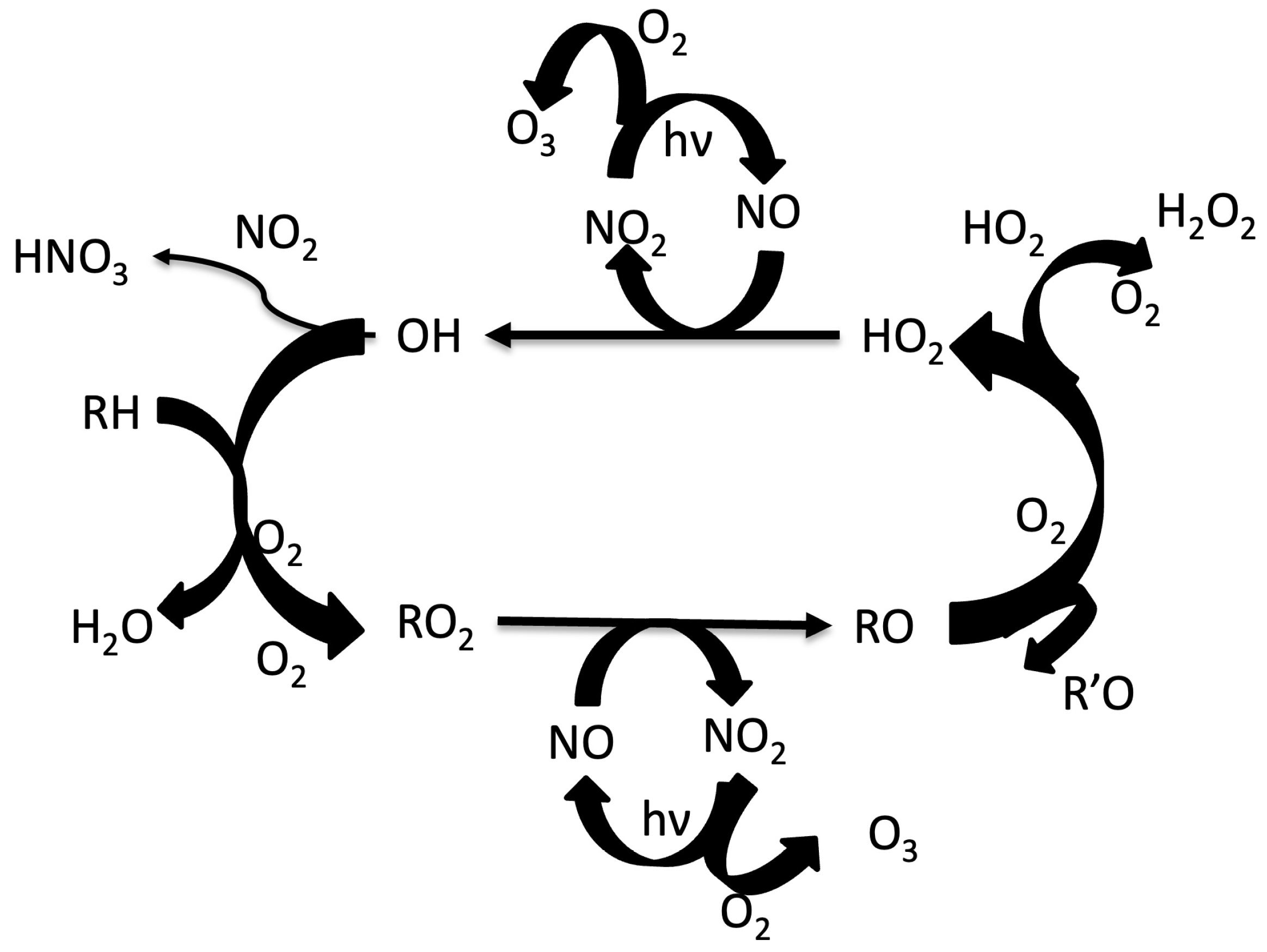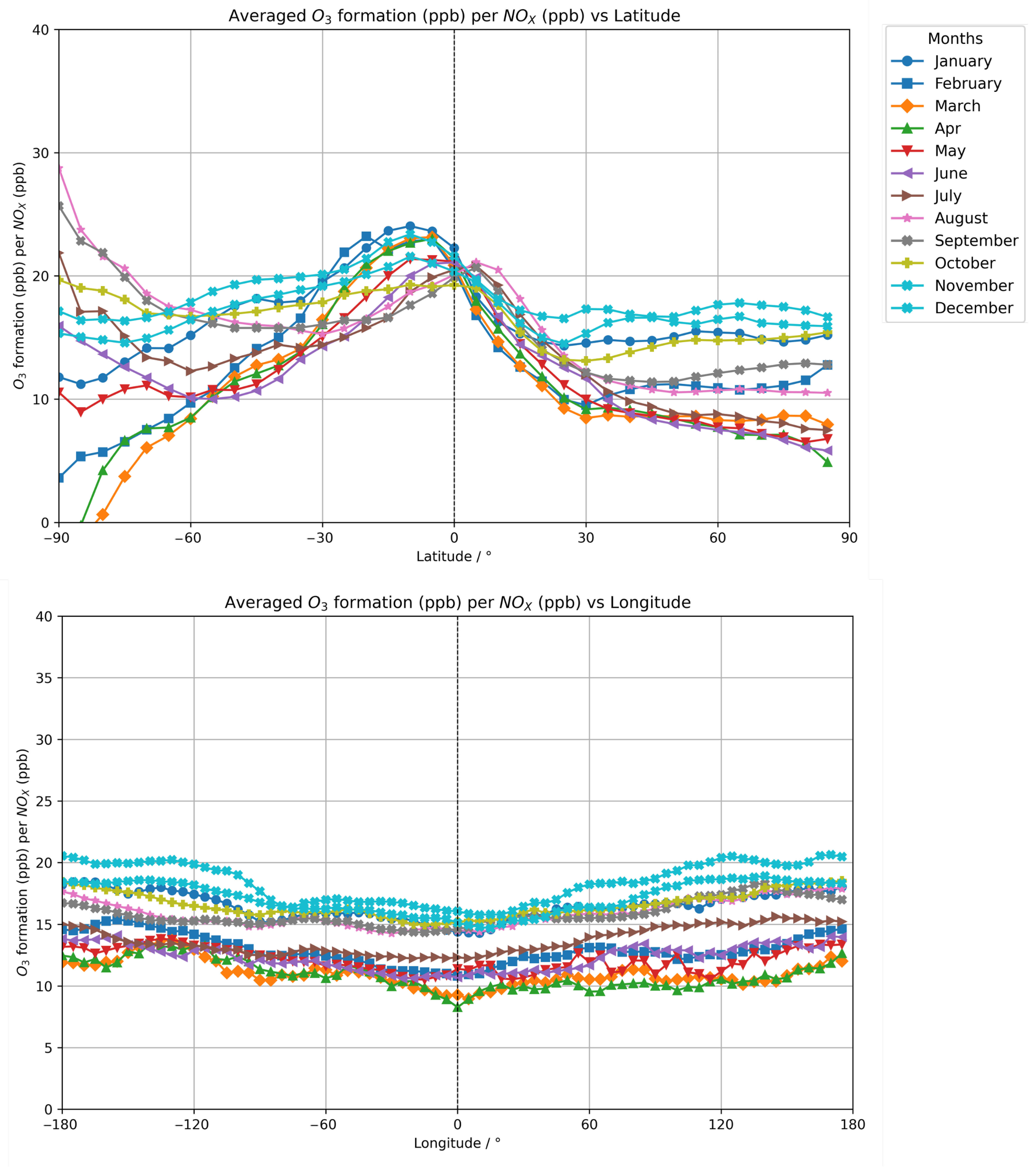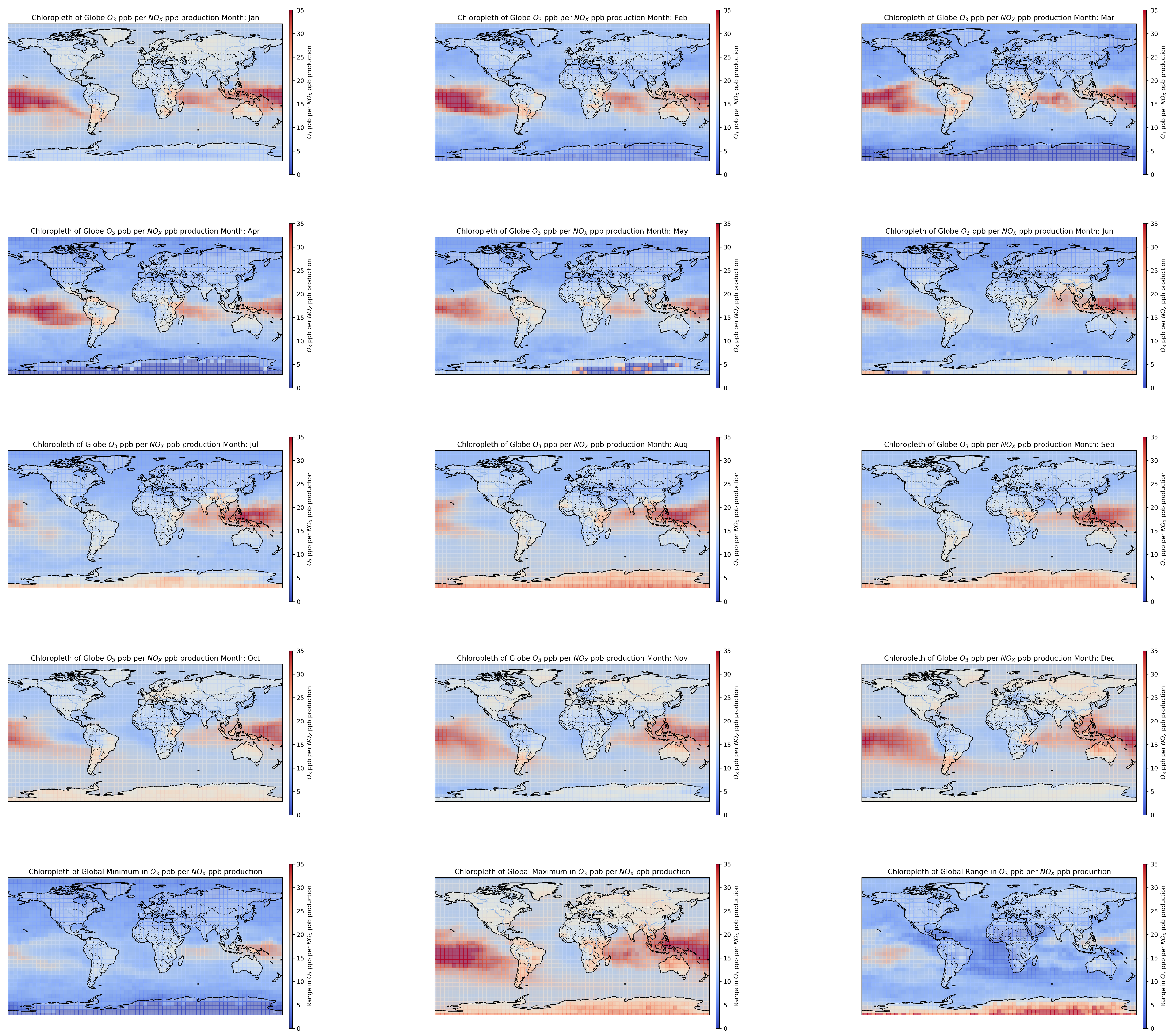Photochemical Ozone Production Along Flight Trajectories in the Upper Troposphere and Lower Stratosphere and Route Optimisation
Abstract
1. Introduction
2. Materials and Methods
2.1. Algorithms for Optimal Routing
2.2. Overview
2.3. STOCHEM-CRI and PTM Model
2.4. Optimal Routing
3. Results
4. Conclusions
Author Contributions
Funding
Institutional Review Board Statement
Informed Consent Statement
Data Availability Statement
Acknowledgments
Conflicts of Interest
Abbreviations
| UTLS | Upper Troposphere Lower Stratosphere |
| NOX | NO + NO2 |
| VOCs | Volatile Organic Compounds |
| STOCHEM-CRI | STOCHastic chemistry transport model-Common Representative Intermediates |
| PTM | Particle Tracking Model |
| ppb | parts per billion |
| ADS-B | Automatic Dependent Surveillance–Broadcast |
| IATA | International Air Transport Association |
References
- Oxford Economics. Aviation: Benefits Beyond Borders. 2018. Available online: https://www.oxfordeconomics.com/resource/6cd06413-2aa3-460f-81fd-42984cf7dd14/ (accessed on 3 March 2025).
- Hartmann, D.L.; Klein Tank, A.M.G.; Rusticucci, M.; Alexander, L.V.; Brönnimann, S.; Charabi, Y.; Dentener, F.J.; Dlugokencky, E.J.; Easterling, D.R.; Kaplan, A.; et al. Observations: Atmosphere and Surface. In Climate Change 2013: The Physical Science Basis. Contribution of Working Group I to the Fifth Assessment Report of the Intergovernmental Panel on Climate Change; Stocker, T.F., Qin, D., Plattner, G.-K., Tignor, M., Allen, S.K., Boschung, J., Nauels, A., Xia, Y., Bex, V., Midgley, P.M., Eds.; Cambridge University Press: Cambridge, UK; New York, NY, USA, 2013; pp. 159–254. [Google Scholar] [CrossRef]
- Lee, D.S.; Fahey, D.W.; Skowron, A.; Allen, M.R.; Burkhardt, U.; Chen, Q.; Doherty, S.J.; Freeman, S.; Forster, P.M.; Fuglestvedt, J.; et al. The contribution of global aviation to anthropogenic climate forcing for 2000 to 2018. Atmos. Environ. 2021, 244, 117834. [Google Scholar] [CrossRef] [PubMed]
- Derwent, R.G.; Dosa, M.; Khan, M.A.H.; Holland, R.; Shallcross, D.E. Atmospheric chemistry regimes in intercontinental air traffic corridors: Ozone versus NOx sensitivity. Atmos. Environ. 2024, 328, 120521. [Google Scholar] [CrossRef]
- Dai, J.X.; Wang, F.; Zhang, K.; Zhai, H.; Jin, D.; Duan, Y.; Yaluk, E.; Wang, Y.; Huang, L.; Li, Y.; et al. Elucidate long-term changes of ozone in Shanghai based on an integrated machine learning method. Front. Environ. Sci. Eng. 2023, 17, 138. [Google Scholar] [CrossRef]
- Zhang, X.; Waugh, D.W.; Kerr, G.H.; Miller, S.M. Surface Ozone-Temperature Relationship: The Meridional Gradient Ratio Approximation. Geophys. Res. Lett. 2022, 49, e2022GL098680. [Google Scholar] [CrossRef]
- Chen, Y.; Chen, X.; Xu, A.; Sun, Q.; Peng, X. A hybrid CNN-Transformer model for ozone concentration prediction. Air Qual. Atmos. Health 2022, 15, 1533–1546. [Google Scholar] [CrossRef]
- Zhan, J.; Liu, Y.; Ma, W.; Zhang, X.; Wang, X.; Bi, F.; Zhang, Y.; Wu, Z.; Li, H. Ozone formation sensitivity study using machine learning coupled with the reactivity of VOC species. Atmos. Meas. Tech. 2021, 21, 16001–16025. [Google Scholar] [CrossRef]
- Ren, J.; Guo, F.; Xie, S. Diagnosing ozone–nox–voc sensitivity and revealing causes of ozone increases in China based on 2013–2021 satellite retrievals. Atmos. Chem. Phys. 2020, 22, 15035–15047. [Google Scholar] [CrossRef]
- Vennam, L.P.; Arunachalam, S.; Baek, B.H.; Omary, M.; Binkowski, F.S.; Olsen, S. A Multiscale Modeling Study to Assess Impacts of Full-Flight Aircraft Emissions on Upper Troposphere and Surface Air Quality; Springer: Cham, Switzerland, 2014; pp. 197–203. Available online: https://link.springer.com/chapter/10.1007/978-3-319-04379-1_32 (accessed on 5 February 2025).
- Hoinka, K.P. Temperature, Humidity, and Wind at the Global Tropopause. Mon. Wea. Rev. 1999, 127, 2248–2265. [Google Scholar] [CrossRef]
- Johnson, C.; Henshaw, J.; McInnes, G. Impact of aircraft and surface emissions of nitrogen oxides on tropospheric ozone and global warming. Atmos. Environ. 1992, 355, 723–733. [Google Scholar] [CrossRef]
- Schumann, U. The impact of nitrogen oxides emissions from aircraft upon the atmosphere at flight altitudes—Results from the aeronox project. Atmos. Environ. 1997, 32, 1723–1733. [Google Scholar] [CrossRef]
- Romanczyk, M. Chemical compositional analysis of jet fuels: Contributions of mass spectrometry in the 21st century. Mass Spectrom. Rev. 2022, 43, 345–368. [Google Scholar] [CrossRef] [PubMed]
- Penner, J.E.; Lister, D.H.; Griggs, D.J.; Dokken, D.J.; McFarland, M. Intergovernmental Panel on Climate Change (IPCC). In Aviation and the Global Atmosphere: A Special Report of IPCC Working Groups I and III; Cambridge University Press: Cambridge, UK, 1999; Available online: https://archive.ipcc.ch/ipccreports/sres/aviation/index.php?idp=0 (accessed on 18 February 2025).
- Skowron, A.; Lee, D.S.; Raper, D.W. The impact of aviation NOx emissions on tropospheric ozone: A global model study. Atmos. Environ. 2015, 106, 219–228. [Google Scholar] [CrossRef]
- Sillman, S.; Logan, J.A.; Wofsy, S.C. The sensitivity of ozone to nitrogen oxides and hydrocarbons in regional ozone episodes. J. Geophys. Res. 1990, 95, 1837–1851. [Google Scholar] [CrossRef]
- Jenkin, M.E.; Watson, L.A.; Utembe, S.R.; Shallcross, D.E. A Common Representative Intermediates (CRI) mechanism for VOC degradation. Part 1: Gas phase mechanism development. Atmos. Environ. 2008, 42, 7185–7195. [Google Scholar] [CrossRef]
- IATA Airline Commitment to Net Zero 2050. 2021. Available online: https://www.iata.org/contentassets/d13875e9ed784f75bac90f000760e998/iata-agm-resolution-on-net-zero-carbon-emissions.pdf (accessed on 18 February 2025).
- Cheng, J. The Adoption of Hydrogen Fuel in Aviation: Incentives and Challenges for Decarbonization. Highlights Sci. Eng. Technol. 2024, 119, 16–22. [Google Scholar] [CrossRef]
- Zhang, Y. Towards Greener Skies: Exploring the Potential of Hydrogen Energy in Aviation. Theor. Nat. Sci. 2024, 56, 105–111. [Google Scholar] [CrossRef]
- Eoukich, K.; Kohen, A.E.; Bouskouk, N.; Azergui, F.Z.; Salhi, A.; Alj, Y.S. Viability Study of Ammonia as Aircraft Fuel for Airbus A320 with Integrated Carbon Fiber Structures. In Proceedings of the 2024 IEEE International Conference on Mechatronics and Automation (ICMA), Tianjin, China, 4–7 August 2024; pp. 172–177. [Google Scholar] [CrossRef]
- Patel, K.; Goyal, V.; Cotto, B.; Otto, M.; Veselý, L.; Kapat, J.; Shi, M. Transient Modeling of an Aero-Engine Using Ammonia As a Fuel Carrier. In Proceedings of the ASME Turbo Expo 2024: Turbomachinery Technical Conference and Exposition, London, UK, 24–28 June 2024. [Google Scholar] [CrossRef]
- Köse, Y.; Polat, E.O. An Empirical Analysis on the Use of Sustainable Fuels in the Aviation Industry. Int. J. Aviat. Sci. Technol. 2024, vm05, 90–100. [Google Scholar] [CrossRef]
- Zhi, Y. Electric Aviation: Pioneering the Future through Advances in Electric Vehicle Technologies. Highlights Sci. Eng. Technol. 2024, 121, 202–207. [Google Scholar] [CrossRef]
- Pattanayak, T.; Mavris, D.N. Battery Technology in Aviation: Current State and Future Prospects. Preprint 2024. [Google Scholar] [CrossRef]
- Jadhav, P.S.N.; Hg, P.; Faizulla, M.; Naik, V. A Comprehensive Overview of Electric Aircraft Propulsion. Int. Adv. Res. J. Sci. Eng. Technol. 2024, 11, 243–250. [Google Scholar] [CrossRef]
- Deitrick, R.; Goldblatt, C. Effects of ozone Levels on Climate Through Earth History. Clim. Past 2022, 19, 1201–1218. [Google Scholar] [CrossRef]
- Niklaß, M.; Lührs, B.; Grewe, V.; Dahlmann, K.; Luchkova, T.; Linke, F.; Gollnick, V. Potential to reduce the climate impact of aviation by climate restricted airspaces. Transp. Policy 2019, 83, 102–110. [Google Scholar] [CrossRef]
- Meilinger, S.K.; Kärcher, B.; Peter, T. Microphysics and heterogeneous chemistry in aircraft plumes—High sensitivity on local meteorology and atmospheric composition. Atmos. Chem. Phys. 2005, 5, 533–545. [Google Scholar] [CrossRef]
- Lanning, D.; Harrell, G.; Wang, J. Dijkstra’s algorithm and Google maps. In Proceedings of the 2014 ACM Southeast Regional Conference, Kennesaw, GA, USA, 28–29 March 2014; pp. 1–3. [Google Scholar] [CrossRef]
- Dijkstra, E.W. A note on two problems in connexion with graphs. Numer. Math. 1959, 1, 269–271. [Google Scholar] [CrossRef]
- GeoPy Contributors. GeoPy: Geocoding Library for Python, Version 2.4.0.; GitHub: San Francisco, CA, USA, 2024; Available online: https://geopy.readthedocs.io/ (accessed on 20 January 2025).
- Flightradar24. ADS-B Data. 2025. Available online: https://www.flightradar24.com/data/ (accessed on 8 December 2024).
- Utembe, S.R.; Cooke, M.C.; Archibald, A.T.; Jenkin, M.E.; Derwent, R.G.; Shallcross, D.E. Using a reduced Common Representative Intermediates (CRI v2-R5) mechanism to simulate tropospheric ozone in a 3-D Lagrangian chemistry transport model. Atmos. Environ. 2010, 13, 1609–1622. [Google Scholar] [CrossRef]
- Khan, M.A.H.; Cooke, M.C.; Utembe, S.R.; Archibald, A.T.; Derwent, R.G.; Jenkin, M.E.; Morris, W.C.; South, N.; Hansen, J.C.; Francisco, J.S.; et al. Global analysis of peroxy radicals and peroxy radical-water complexation using the STOCHEM-CRI global chemistry and transport model. Atmos. Environ. 2015, 106, 278–287. [Google Scholar] [CrossRef]
- Wasiuk, D.K.; Khan, M.A.H.; Shallcross, D.E.; Lowenberg, M.H. The impact of global aviation NOx emissions on tropospheric composition changes from 2005 to 2011. Atmos. Res. 2016, 178–179, 73–83. [Google Scholar] [CrossRef]
- Derwent, R.G.; Witham, C.S.; Utembe, S.R.; Jenkin, M.E.; Passant, N.R. Ozone in Central England: The impact of 20 years of precursor emission controls in Europe. Environ. Sci. Policy 2010, 13, 195–204. [Google Scholar] [CrossRef]
- Jenkin, M.E.; Young, J.C.; Rickard, A.R. The MCM v3.3.1 degradation scheme for isoprene. Atmos. Chem. Phys. 2015, 15, 11433–11459. [Google Scholar] [CrossRef]
- Abadi, M.; Agarwal, A.; Barham, P.; Brevdo, E.; Chen, Z.; Citro, C.; Corrado, G.S.; Davis, A.; Dean, J.; Devin, M.; et al. TensorFlow: Large-Scale Machine Learning on Heterogeneous Systems. 2015. Available online: https://tensorflow.org (accessed on 20 January 2025).
- Li, G.; Cao, G. Generative Adversarial Models for Extreme Downscaling of Climate Datasets. arXiv 2024, arXiv:2402.14049. [Google Scholar] [CrossRef]
- Ballard, T.; Erinjippurath, G. Contrastive Learning for Climate Model Bias Correction and Super-Resolution. arXiv 2022, arXiv:2211.07555. [Google Scholar] [CrossRef]
- Stengel, K.; AhtHettinger, D.; King, R. Adversarial super-resolution of climatological wind and solar data. Proc. Natl. Acad. Sci. USA 2020, 117, 16805–16815. [Google Scholar] [CrossRef] [PubMed]
- Prathom, C.; Champrasert, P. An Exploration of Interpolation—Machine Learning Model for Climate Model Downscaling Under the Limitation of Data Quantity. In Proceedings of the 2023 International Technical Conference on Circuits/Systems, Computers, and Communications (ITC-CSCC), Jeju, Republic of Korea, 25–28 June 2023. [Google Scholar] [CrossRef]
- Python Language Reference, Version 3; Python Software Foundation: Beaverton, OR, USA, 2008. Available online: https://www.python.org (accessed on 1 December 2024).
- Met Office. Cartopy: A Cartographic Python Library with a Matplotlib Interface. 2010–2015. Available online: https://scitools.org.uk/cartopy (accessed on 1 December 2024).
- Python-Visualization. Folium: Interactive Maps in Python. 2020. Available online: https://python-visualization.github.io/folium/ (accessed on 1 December 2024).
- Hunter, J.D. Matplotlib: A 2D graphics environment. Comput. Sci. Eng. 2007, 9, 90–95. [Google Scholar] [CrossRef]
- McKinney, W. Data Structures for Statistical Computing in Python. In Proceedings of the 9th Python in Science Conference, Austin, TX, USA, 28 June–3 July 2010; Van der Walt, S., Millman, J., Eds.; pp. 56–61. [Google Scholar] [CrossRef]
- Hagberg, A.A.; Schult, D.A.; Swart, P.J. Exploring network structure, dynamics, and function using NetworkX. In Proceedings of the 7th Python in Science Conference, Pasadena, CA, USA, 19–24 August 2008; Varoquaux, G., Vaught, T., Millman, J., Eds.; pp. 11–15. Available online: https://networkx.org (accessed on 20 November 2024).
- Khan, M.A.H.; Miles, B.; Jenkin, M.E.; Richard, G.; Percival, C.J.; Shallcross, D.E. Investigating the Impacts of Nonacyl Peroxy Nitrates on the Global Composition of the Troposphere Using a 3-D Chemical Transport Model, STOCHEM-CRI. ACS Earth Space Chem. 2020, 4, 1201–1212. [Google Scholar] [CrossRef]
- Gilmore, C.K.; Barrett, S.R.H.; Koo, J.; Wang, Q. Temporal and spatial variability in the aviation NOx-related O3 impact. Environ. Res. Lett. 2013, 8, 034027. [Google Scholar] [CrossRef][Green Version]
- Soler, M.; Olivares, A.; Staffetti, E. Multiphase optimal control framework for commercial aircraft four-dimensional flight-planning problems. J. Aircr. 2015, 52, 274–286. [Google Scholar] [CrossRef]




| Route | Typical Flight | Haversine | O3 (ppb) per NOX (ppb) Weight | ||
|---|---|---|---|---|---|
| IATA Code | Duration (Hours: Minutes) | Distance (km) | Haversine | Dijkstra | Real-World |
| LHR-AMS | 0:41 | 372 | 1290 | 1240 | 1250 |
| JFK-YYZ | 1:09 | 589 | 1080 | 1070 | - |
| SIN-CGK | 1:21 | 878 | 5500 | 5000 | - |
| LHR-JFK | 7:01 | 5554 | 14,100 | 13,100 | - |
| JFK-HKG | 15:06 | 12,990 | 31,700 | 26,900 | - |
| LHR-JNB | 10:22 | 9045 | 15,000 | 13,000 | - |
| JNB-SYD | 11:22 | 11,044 | 18,800 | 15,000 | - |
| JNB-GRU | 9:29 | 7451 | 12,200 | 10,800 | - |
| HND-SYD | 9:14 | 7785 | 8850 | 8810 | - |
| HND-LHR | 13:12 | 9615 | 24,000 | 18,800 | - |
Disclaimer/Publisher’s Note: The statements, opinions and data contained in all publications are solely those of the individual author(s) and contributor(s) and not of MDPI and/or the editor(s). MDPI and/or the editor(s) disclaim responsibility for any injury to people or property resulting from any ideas, methods, instructions or products referred to in the content. |
© 2025 by the authors. Licensee MDPI, Basel, Switzerland. This article is an open access article distributed under the terms and conditions of the Creative Commons Attribution (CC BY) license (https://creativecommons.org/licenses/by/4.0/).
Share and Cite
Foster, A.W.; Derwent, R.G.; Khan, M.A.H.; Shallcross, D.E.; Lowenberg, M.H.; Navaratne, R. Photochemical Ozone Production Along Flight Trajectories in the Upper Troposphere and Lower Stratosphere and Route Optimisation. Atmosphere 2025, 16, 858. https://doi.org/10.3390/atmos16070858
Foster AW, Derwent RG, Khan MAH, Shallcross DE, Lowenberg MH, Navaratne R. Photochemical Ozone Production Along Flight Trajectories in the Upper Troposphere and Lower Stratosphere and Route Optimisation. Atmosphere. 2025; 16(7):858. https://doi.org/10.3390/atmos16070858
Chicago/Turabian StyleFoster, Allan W., Richard G. Derwent, M. Anwar H. Khan, Dudley E. Shallcross, Mark H. Lowenberg, and Rukshan Navaratne. 2025. "Photochemical Ozone Production Along Flight Trajectories in the Upper Troposphere and Lower Stratosphere and Route Optimisation" Atmosphere 16, no. 7: 858. https://doi.org/10.3390/atmos16070858
APA StyleFoster, A. W., Derwent, R. G., Khan, M. A. H., Shallcross, D. E., Lowenberg, M. H., & Navaratne, R. (2025). Photochemical Ozone Production Along Flight Trajectories in the Upper Troposphere and Lower Stratosphere and Route Optimisation. Atmosphere, 16(7), 858. https://doi.org/10.3390/atmos16070858









